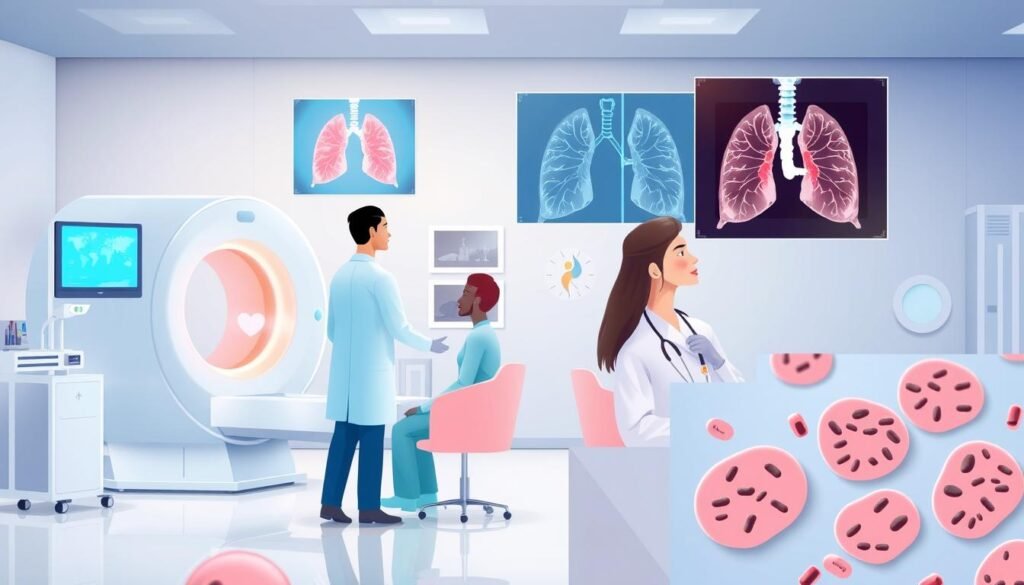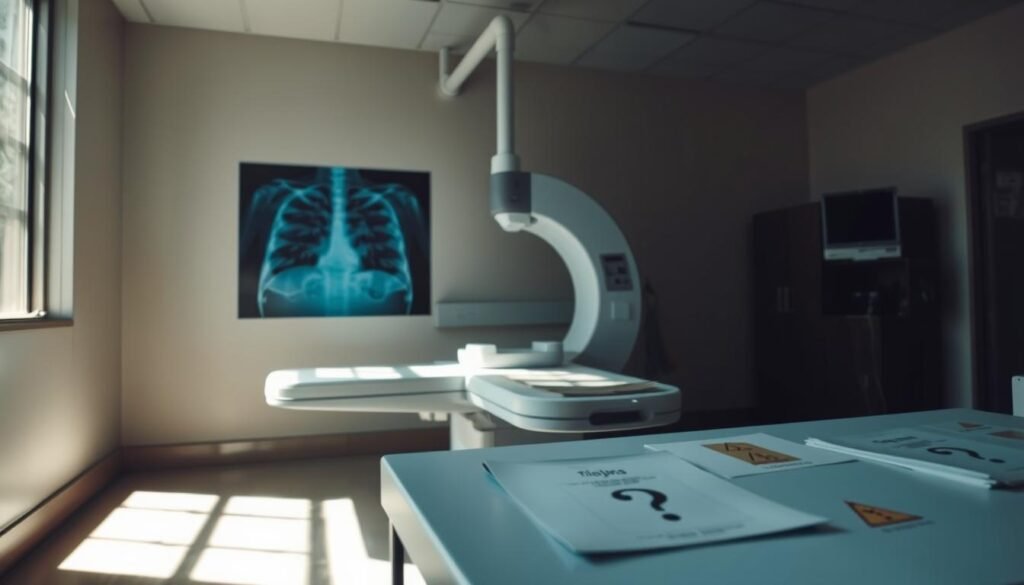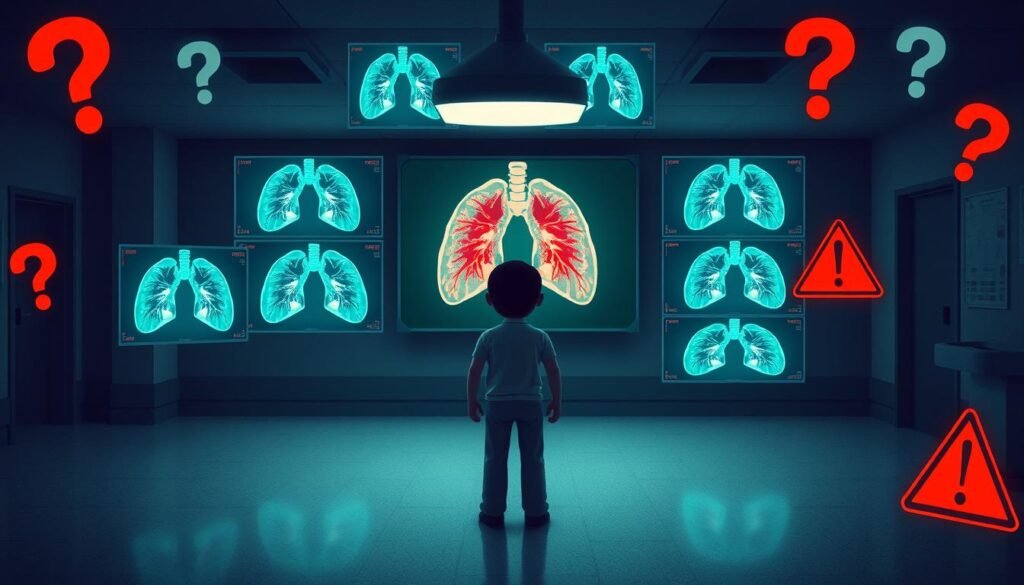Lung cancer is the top cause of cancer deaths in the U.S., making up 28% of all deaths from cancer. While finding cancer early can save lives, lung cancer screening has its risks. Low-dose CT scans can spot lung cancer early, which might help some people live longer. But only 1 out of 320 people at high risk will not die from lung cancer because of screening. It’s important to think hard about these risks before deciding on screening. As we learn more about cancer screening, we understand better both its good and bad sides. This article helps explain the risks of lung cancer screening. It aims to help you make smart health choices while showing how key early detection is.
Key Takeaways
- Lung cancer accounts for 28% of all cancer deaths in the U.S.
- 1 in 320 high-risk patients screened may see a significant benefit from screening.
- Low-dose CT scans have a false-positive rate of 250 out of 1,000, leading to unnecessary stress and follow-up tests.
- Over 20% of cancers identified through screening are overdiagnosed and would not have caused harm.
- Understanding the balance of risks and benefits is essential for anyone considering lung cancer screening.
Understanding Lung Cancer Screening
Lung cancer screening looks for early signs of lung cancer in those without symptoms. It mainly helps people at high risk. The U.S. Preventive Services Task Force suggests those 55 to 80 who smoked a lot get screened. This could help find lung cancer early.
Low-dose CT scans are used in screening to cut lung cancer death rates. Many cancers are found early this way, making treatment work better. Without screening, far fewer cases are caught early.
Screening for lung cancer can save lives but has risks. Around 12-14% of first screenings give false-positives, which can lead to stress and extra tests. Also, some scans show things not related to cancer, happening in about 6% of first screenings.
Doctors need to talk with their patients about the pros and cons of lung cancer screening. These conversations help people choose what’s right for them. As screening technology gets better, so will the ability to find and manage lung cancer risk.
Types of Lung Cancer Screening Tests
Lung cancer screening is key for catching the disease early. This is especially true for those who have smoked a lot. The top method is the low-dose computed tomography (LDCT) scan. It gives clear lung images while reducing radiation.
LDCT is great at finding cancer early, especially in people who have smoked for many years. This test takes about 15 minutes and doesn’t hurt. It’s a top choice for lung cancer screenings.
Other tests like chest X-rays and sputum cytology don’t help reduce death from lung cancer. LDCT is better because it can boost survival chances by 20 percent or more.
Knowing about the cost of a low-dose CT scan is important if you’re thinking about getting screened. Many health plans will cover the cost for those 50 to 77 with a history of smoking. There might also be free screenings for people without insurance and low income.
A team of experts will look at your scan results to figure out the best plan for you. Quitting smoking resources are offered too. They tackle the main cause of lung cancer and help improve health.

For extra details on lung cancer screening procedures, talk to healthcare professionals or look up resources. They can tell you if you qualify and the benefits.
Benefits of Lung Cancer Screening
Lung cancer screening has big advantages, mainly for those at higher risk. The use of low-dose computed tomography (LDCT) leads to a 20% reduction in deaths from lung cancer. This is when compared to the old chest X-ray methods. Finding lung cancer early is key. It leads to better treatment and survival chances.
Studies, like the National Lung Screening Trial (NLST), show these benefits clearly. It found that screening 320 high-risk people saves one life. Around 80% of lung cancer comes from smoking. So, there are now special screening programs for those 55-77 who have smoked a lot. These programs help by providing free tests. They make it easier for those at risk to get checked early. You can find more about these free programs and who can join them.
Many cancer groups support screening because it saves lives. They see low-dose CT scans as crucial for early help. Medicare helps too, by covering yearly screenings for some people. This shows how important it is for people to learn about their screening options.
Of course, lung cancer screening isn’t perfect. There are risks, like false alarms and overdiagnosis. Knowing these can help people make better choices about screening. Weighing the pros and cons helps people take charge of their health. It helps them get the best care for their lungs.
Risks Associated with Lung Cancer Screening
Lung cancer screening, especially with low-dose computed tomography (CT), has risks. While it is effective in detecting lung cancer early, it could also lead to unnecessary worry and medical procedures for patients.
Potential Complications of Lung Cancer Screening
A major concern is complications from false-positive results. If a screening shows something abnormal, more tests are usually needed. This might include invasive procedures, like biopsies.
About 2.5% of patients without lung cancer could go through these unnecessary procedures. These can cause problems such as infection or pneumothorax. It’s important for patients to think about these possible issues versus the benefits of screening. This is especially true for those not in high-risk groups.
Side Effects of Lung Cancer Screening
Next to the complications, there are side effects from radiation exposure in lung cancer screenings. Having many scans can build up radiation doses. This raises concerns about the effects on health over time. Even though low-dose CT scans aim to reduce these risks, their safety over many exposures needs careful thought. Patients should talk this over with their health care providers.
For more details on lung cancer screening and what it involves, check out this helpful resource.

False Positives in Lung Cancer Screening
Lung cancer screening can sometimes tell people they might have cancer when they don’t. This is called a false positive. About 250 out of every 1,000 people screened may get these results. They can feel very anxious, not knowing if they’re really sick. They may also need more tests to check again.
Impact of False Positives on Patient Anxiety
Getting a false positive result can be very stressful. It can make people worry a lot, even when they’re healthy. That’s why doctors need to talk clearly about this risk before the test. By understanding the risks and what the results mean, people can feel less anxious. Good communication helps people make informed choices about screening.
Follow-up Procedures and Their Risks
After a false positive, more tests are often needed. These can include more scans or even biopsies, which are more serious. Both have risks like bleeding, infection, or even lung collapse. It’s important to think carefully about screening’s pros and cons, knowing these risks. Safer, less invasive ways to check for lung problems are being researched. You can learn more about the risks of different follow-up tests here.

| Aspect | Details |
|---|---|
| False Positive Rate | Approximately 25% of screened individuals may receive abnormal results. |
| Patient Anxiety | High levels of stress and uncertainty experienced post-screening. |
| Common Follow-ups | CT scans, biopsies, and additional imaging. |
| Procedure Risks | Bleeding, infection, and lung complications. |
| Communication | Effective discussions about risks can reduce anxiety. |
Dangers of Overdiagnosis in Lung Cancer Screening
Lung cancer screening has risks, like overdiagnosis, that are worrying. Overdiagnosis is finding cancers that wouldn’t have hurt the person otherwise. The National Lung Screening Trial (NLST) found about 18.5% overdiagnosis in the first 4.5 years. This rate dropped to 3% after nine years. The NELSON trial saw rates go from 19.7% to 8.9% in 5.5 years.
Overdiagnosis can lead to treatments we don’t need, which can have side effects. For example, lung cancer treatments can be risky. The SEER-Medicare database shows that patients with stage I non-small cell lung cancer have only a 25% five-year survival rate with radiation therapy.
People with other health issues are more affected by these risks. The NLST’s participants were older and had more health problems than usual. The US Preventive Services Task Force suggests screening up to age 80. This is to balance the benefits against overdiagnosis risks, especially for those with other health issues.
It’s vital that doctors talk clearly about what screening results mean. This helps patients choose wisely. Science is working on better tools to cut down overdiagnosis. These new methods would focus on the benefits for each person’s life years.
Radiation Exposure Concerns
Radiation exposure is a big topic when we talk about checking for lung cancer. With low-dose computed tomography (LDCT), it’s important to know how much radiation is used. This is because LDCT can find lung cancer early but there are worries about radiation.
Understanding the Levels of Radiation in Screening
There are growing concerns about radiation from LDCT scans. They are safer than regular CT scans but still have risks. For example, one LDCT scan gives you as much radiation as six months of natural background radiation. Having many scans increases the risk, especially for young people and those at low risk for lung cancer.
A big study showed that screening with LDCT lessened lung cancer deaths by 20% among people at high risk. But, follow-up tests add more radiation. Over 20% of a person’s total radiation can come from these extra tests during screening.
Looking at research helps us weigh the risks and benefits of screening. The risk of getting lung cancer from screening varies a lot. It can be as high as 5.5 or as low as 1.4 out of 10,000 people over ten years. This shows how important it is to think carefully about screening for each person.
To understand radiation in screening, we need to consider many things. This includes the CT scan settings, how often scans are done, and the patient’s age and smoking history. Using the best CT settings can lower risks while still giving clear results. As people learn more, they can make better choices about lung cancer screening. This leads to improved care and a smarter way to handle radiation worries.
| Parameter | Level of Radiation (mSv) | Comments |
|---|---|---|
| LDCT Scan | 1.5 | Equivalent to about 6 months of natural background radiation. |
| Follow-Up PET Scan | 7.0 | Accounts for significant portion of total radiation exposure. |
| Annual Screening (10 years) | 9.3 (men), 13.0 (women) | Cumulative effective dose after 10 years of screenings. |
| Cumulative Risk of Lung Cancer | 5.5–1.4 per 10,000 | Lifetime attributable risk after 10 years of CT screening. |
Risks versus Benefits of Lung Cancer Screening
Lung cancer screening presents a crucial choice: to weigh the potential risks and benefits. The National Lung Screening Trial reveals that screening with low-dose CT scans can save lives. It shows that one out of every 320 high-risk patients can avoid dying from lung cancer in five years. But, not all results point to cancer, leading to many false positives.
False positives occur in about 95% of abnormal CT scans, causing much worry. This leads to extra tests that are not needed. Making the decision to screen for lung cancer involves looking at both the good and bad outcomes.
The decision to get screened can be hard. Up to 25% of screened high-risk patients get abnormal results, even though they don’t have cancer. Also, overdiagnosis rates range from 20% to 67%. Detecting cancer early can make it more treatable. But, patients and health care workers must consider the emotional and physical impacts.
The U.S. Preventive Services Task Force recommends yearly screening for certain adults. This includes those between 55 to 80 years old with a significant history of smoking. Despite this recommendation, very few eligible Americans get screened. Only 2% to 3% of 8 million take part. This shows a big gap in awareness about lung cancer screening.
Having open talks about lung cancer screening can lead to informed choices. Patients should consider their health risks and what they prefer. This way, decisions about screening are tailored to each person’s health situation.
Conclusion
Lung cancer screening is important for people at high risk. We’ve learned that it’s vital to know about the risks. Over ten years, data showed that out of 5203 people screened, the results were mixed.
This shows why it’s key for patients to fully understand what screening involves. They must know both the good and bad sides. This includes understanding that tests can sometimes show problems that aren’t really there. This can cause a lot of worry and lead to treatments that weren’t needed.
Right now, only 16.0% of those who should get screened actually do. Lung cancer is found in someone in the U.S. every two minutes. Having the right info can help people talk to their doctors. This way, they make choices best for them, which could save lives.